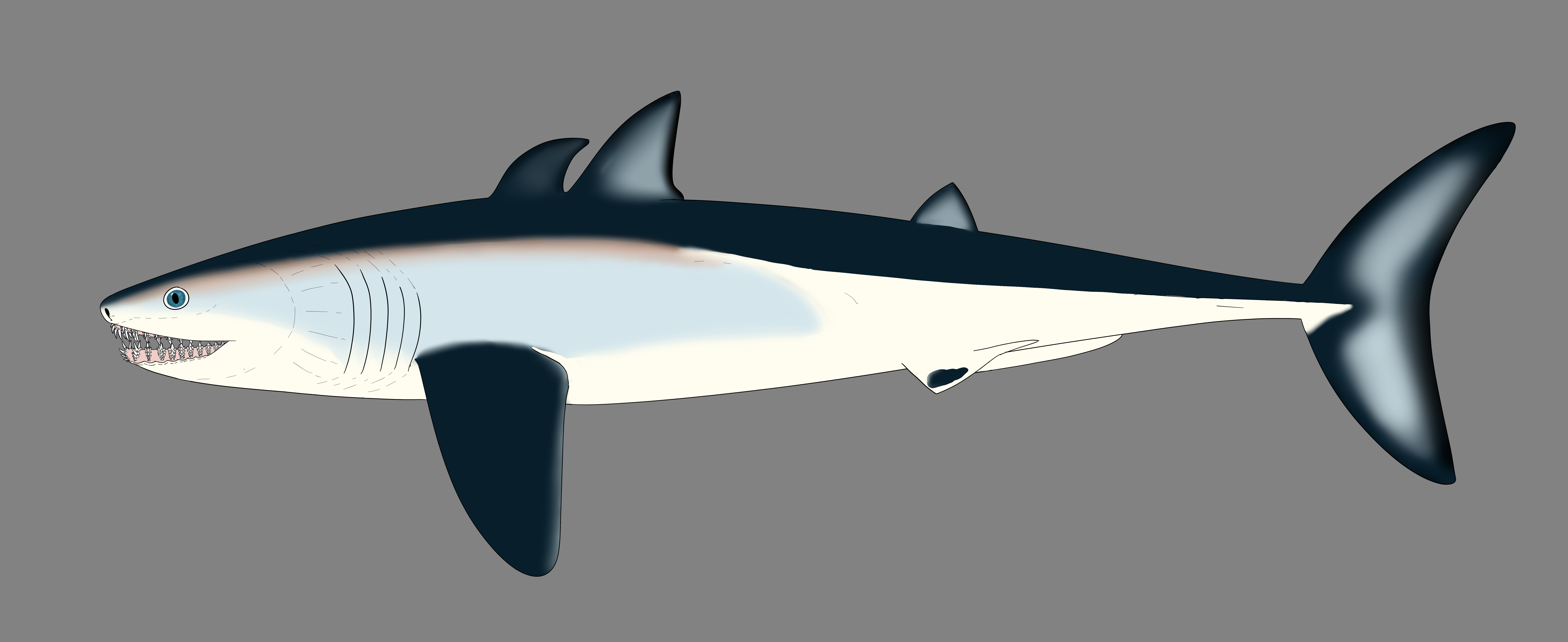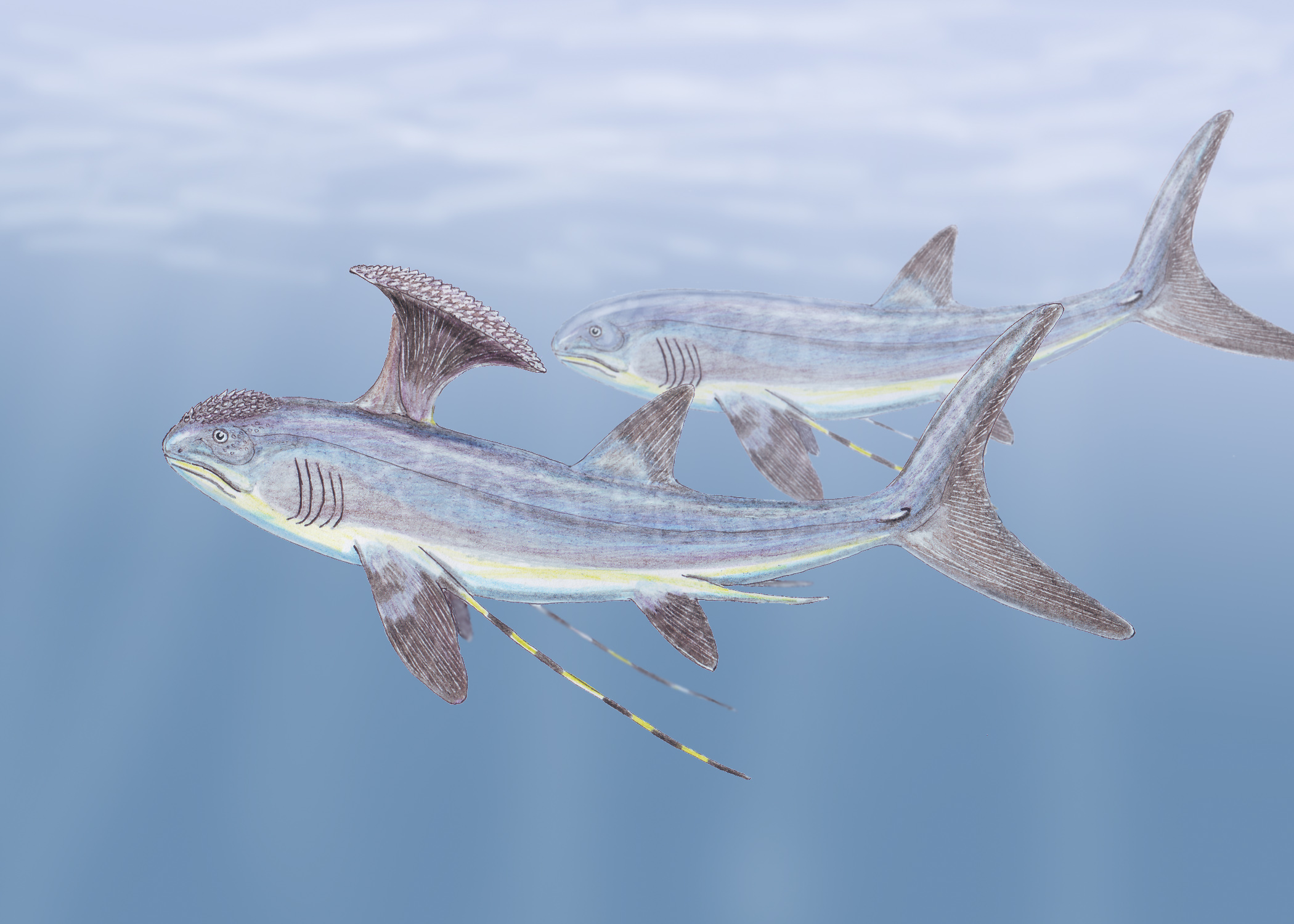|
Cladodont
This is a typical Cladodont tooth, of a Glikmanius.html" ;"title="shark called ''Glikmanius">shark called ''Glikmanius'' Cladodont (from Latin cladus, meaning branch and Greek Odon, meaning tooth) is the term for a common category of early Devonian shark known primarily for its "multi-cusped" tooth consisting of one long blade surrounded by many short, fork-like tines, designed to catch food that was swallowed whole, instead of being used to saw off chunks of meat like many modern sharks. The skinny teeth would puncture and grasp the prey, keeping it from wriggling free. Because the most common fossil evidence of cartilaginous fish is teeth, this term is also used for the fossilised teeth themselves. History The fossil tooth of '' Cladodus belifer'', which lived about 260,000,000 years ago in what would someday be Illinois. The roundness of the main tooth, and the small tines around it, show it to be a cladodont. The earliest known shark, ''Cladoselache'', was a cladodont ... [...More Info...] [...Related Items...] OR: [Wikipedia] [Google] [Baidu] |
Glikmanius Tooth 1
''Glikmanius'' is an extinct genus of ctenacanth cartilaginous fish which lived in the Carboniferous of North America and Russia. Skeletal remains attributed to the genus are known from Nebraska, USA. ''Glikmanius'' is named in honour of the Russian palaeontologist, Dr. Leonid Glikman, who studied the genus and was "the first to propose its ctenacanthiform affinity". ''G. careforum'' may have reached lengths of , while ''G. occidentalis'' may have reached lengths of over , making it one the largest marine predators of its time. left, Tooth of ''Glikmanius occidentalis.'' References "Ctenacanthiform Cladodont Teeth from the Lower Permian Wichita Group, Texas, U.S.A." ''Acta Geologica Polonica'', Vol. 58 (2008), No. 2, pp. 205–209 External links 3D model of scanned and labeled ''G. careforum'' fossilsat Sketchfab Sketchfab is a 3D asset website used to publish, share, discover, buy and sell 3D model, 3D, Virtual reality, VR and Augmented reality, AR content. It pr ... [...More Info...] [...Related Items...] OR: [Wikipedia] [Google] [Baidu] |
Cladoselache
''Cladoselache'' ("branch shark") is an Extinction, extinct genus of shark-like chondrichthyan (cartilaginous fish) from the Late Devonian (Famennian) of North America. It was similar in body shape to modern Lamnidae, lamnid sharks (such as Isurus, mako sharks and the great white shark), but was not closely related to lamnids or to any other modern (selachian) shark. As an early chondrichthyan, it had yet to evolve traits of modern sharks such as accelerated tooth replacement, a loose jaw suspension, enameloid teeth, and possibly Clasper, claspers. Some 20th century studies considered ''Cladoselache'' to be a Basal (phylogenetics), basal (early-diverging) member of Elasmobranchii, the fork of cartilaginous fish which leads to modern sharks and rays. More recent studies have identified distinctive traits of the chondrocranium (cartilaginous braincase), dorsal fin spines, and pectoral fin bases. These newly identified features support a close relationship to Symmoriiformes, symmorii ... [...More Info...] [...Related Items...] OR: [Wikipedia] [Google] [Baidu] |
Devonian Sharks
The Devonian ( ) is a geologic period and system of the Paleozoic era during the Phanerozoic eon, spanning 60.3 million years from the end of the preceding Silurian period at million years ago ( Ma), to the beginning of the succeeding Carboniferous period at Ma. It is the fourth period of both the Paleozoic and the Phanerozoic. It is named after Devon, South West England, where rocks from this period were first studied. The first significant evolutionary radiation of life on land occurred during the Devonian, as free- sporing land plants (pteridophytes) began to spread across dry land, forming extensive coal forests which covered the continents. By the middle of the Devonian, several groups of vascular plants had evolved leaves and true roots, and by the end of the period the first seed-bearing plants ( pteridospermatophytes) appeared. This rapid evolution and colonization process, which had begun during the Silurian, is known as the Silurian-Devonian Terrestrial Revo ... [...More Info...] [...Related Items...] OR: [Wikipedia] [Google] [Baidu] |
Frilled Shark
The frilled shark (''Chlamydoselachus anguineus''), also known as the lizard shark, is one of the two extant taxon, extant species of shark in the family (biology), family Chlamydoselachidae (the other is the southern African frilled shark, ''Chlamydoselachus africana''). The frilled shark is considered a living fossil, because of its primitive, Eel, anguilliform (eel-like) physical traits, such as a dark-brown color, Elasmobranchii#Description, amphistyly (the articulation of the jaws to the cranium), and a –long body, which has dorsal fin, dorsal, pelvic fin, pelvic, and anal fins located towards the tail. The common name, ''frilled shark'', derives from the fringed appearance of the six pairs of gill slits at the shark's throat. The two species of frilled shark are distributed throughout regions of the Atlantic Ocean, Atlantic and the Pacific Ocean, Pacific oceans, usually in the waters of the outer continental shelf and of the upper continental slope, where the sharks usual ... [...More Info...] [...Related Items...] OR: [Wikipedia] [Google] [Baidu] |
Valanginian
In the geologic timescale, the Valanginian is an age or stage of the Early or Lower Cretaceous. It spans between 137.05 ± 0.2 Ma and 132.6 ± 0.2 Ma (million years ago). The Valanginian Stage succeeds the Berriasian Stage of the Lower Cretaceous and precedes the Hauterivian Stage of the Lower Cretaceous. Stratigraphic definitions The Valanginian was first described and named by Édouard Desor in 1853. It is named after Valangin, a small town north of Neuchâtel in the Jura Mountains of Switzerland. The base of the Valanginian is at the first appearance of calpionellid species '' Calpionellites darderi'' in the stratigraphic column. A global reference section (a GSSP) had in 2009 not yet been appointed. The top of the Valanginian (the base of the Hauterivian) is at the first appearance of the ammonite genus '' Acanthodiscus''. Subdivision The Valanginian is often subdivided in Lower and Upper substages. The Upper substage begins at the first appearance of ammonite speci ... [...More Info...] [...Related Items...] OR: [Wikipedia] [Google] [Baidu] |
Cretaceous
The Cretaceous ( ) is a geological period that lasted from about 143.1 to 66 mya (unit), million years ago (Mya). It is the third and final period of the Mesozoic Era (geology), Era, as well as the longest. At around 77.1 million years, it is the ninth and longest geological period of the entire Phanerozoic. The name is derived from the Latin , 'chalk', which is abundant in the latter half of the period. It is usually abbreviated K, for its German translation . The Cretaceous was a period with a relatively warm climate, resulting in high Sea level#Local and eustatic, eustatic sea levels that created numerous shallow Inland sea (geology), inland seas. These oceans and seas were populated with now-extinct marine reptiles, ammonites, and rudists, while dinosaurs continued to dominate on land. The world was largely ice-free, although there is some evidence of brief periods of glaciation during the cooler first half, and forests extended to the poles. Many of the dominant taxonomic gr ... [...More Info...] [...Related Items...] OR: [Wikipedia] [Google] [Baidu] |
Carboniferous
The Carboniferous ( ) is a Geologic time scale, geologic period and System (stratigraphy), system of the Paleozoic era (geology), era that spans 60 million years, from the end of the Devonian Period Ma (million years ago) to the beginning of the Permian Period, Ma. It is the fifth and penultimate period of the Paleozoic era and the fifth period of the Phanerozoic eon (geology), eon. In North America, the Carboniferous is often treated as two separate geological periods, the earlier Mississippian (geology), Mississippian and the later Pennsylvanian (geology), Pennsylvanian. The name ''Carboniferous'' means "coal-bearing", from the Latin ("coal") and ("bear, carry"), and refers to the many coal beds formed globally during that time. The first of the modern "system" names, it was coined by geologists William Conybeare (geologist), William Conybeare and William Phillips (geologist), William Phillips in 1822, based on a study of the British rock succession. Carboniferous is the per ... [...More Info...] [...Related Items...] OR: [Wikipedia] [Google] [Baidu] |
Stethacanthus
''Stethacanthus'' is an extinct genus of shark-like cartilaginous fish which lived from the Late Devonian to Late Carboniferous epoch, dying out around 298.9 million years ago. Fossils have been found in Australia, Asia, Europe and North America. Etymology ''Stethacanthus'' comes from the Greek στῆθος (''stēthos''), meaning "chest", and ἄκανθος (''akanthos''), meaning "spine" or "thorn". The name refers to the distinctive anvil-shaped first dorsal fin and spine displayed by mature males of the genus. Description ''Stethacanthus'' had different sizes depending on species, ''S. altonensis'' had length about , while ''S. productus'' reached . In many respects, it had a shark-like appearance. However, it is best known for its unusually shaped dorsal fin, which resembled an anvil or ironing board. Small spikes (enlarged versions of the dermal denticles commonly covering shark skin) covered this crest, and the ratfish's head as well. The crest may have played a r ... [...More Info...] [...Related Items...] OR: [Wikipedia] [Google] [Baidu] |
Shark
Sharks are a group of elasmobranch cartilaginous fish characterized by a ribless endoskeleton, dermal denticles, five to seven gill slits on each side, and pectoral fins that are not fused to the head. Modern sharks are classified within the Division (taxonomy), division Selachii and are the sister group to the Batoidea, Batomorphi (Batoidea, rays and skate (fish), skates). Some sources extend the term "shark" as an informal category including Extinction, extinct members of Chondrichthyes (cartilaginous fish) with a shark-like morphology, such as hybodonts. Shark-like chondrichthyans such as ''Cladoselache'' and ''Doliodus'' first appeared in the Devonian Period (419–359 million years), though some fossilized chondrichthyan-like scales are as old as the Ordovician, Late Ordovician (458–444 million years ago). The earliest confirmed modern sharks (Selachii) are known from the Early Jurassic around , with the oldest known member being ''Agaleus'', though records of true shar ... [...More Info...] [...Related Items...] OR: [Wikipedia] [Google] [Baidu] |
Branch
A branch, also called a ramus in botany, is a stem that grows off from another stem, or when structures like veins in leaves are divided into smaller veins. History and etymology In Old English, there are numerous words for branch, including , , , and . There are also numerous descriptive words, such as (that is, something that has bled, or 'bloomed', out), (literally 'little bough'), (literally 'on growth'), and (literally 'offspringing'). Numerous other words for twigs and boughs abound, including , which still survives as the ''-toe'' in ''mistletoe''. Latin words for branch are or . The latter term is an affix found in other modern words such as '' cladodont'' (prehistoric sharks with branched teeth), ''cladode'' (flattened leaf-like branches), or ''cladogram'' (a branched diagram showing relations among organisms). Woody branches Large branches are known as boughs and small branches are known as twigs. The term ''twig'' usually refers to a terminus, while ''bou ... [...More Info...] [...Related Items...] OR: [Wikipedia] [Google] [Baidu] |
Fossil
A fossil (from Classical Latin , ) is any preserved remains, impression, or trace of any once-living thing from a past geological age. Examples include bones, shells, exoskeletons, stone imprints of animals or microbes, objects preserved in amber, hair, petrified wood and DNA remnants. The totality of fossils is known as the ''fossil record''. Though the fossil record is incomplete, numerous studies have demonstrated that there is enough information available to give a good understanding of the pattern of diversification of life on Earth. In addition, the record can predict and fill gaps such as the discovery of '' Tiktaalik'' in the arctic of Canada. Paleontology includes the study of fossils: their age, method of formation, and evolutionary significance. Specimens are sometimes considered to be fossils if they are over 10,000 years old. The oldest fossils are around 3.48 billion years to 4.1 billion years old. Early edition, published online before prin ... [...More Info...] [...Related Items...] OR: [Wikipedia] [Google] [Baidu] |






